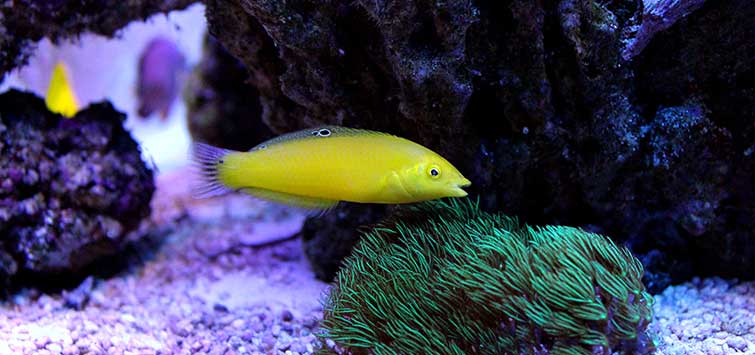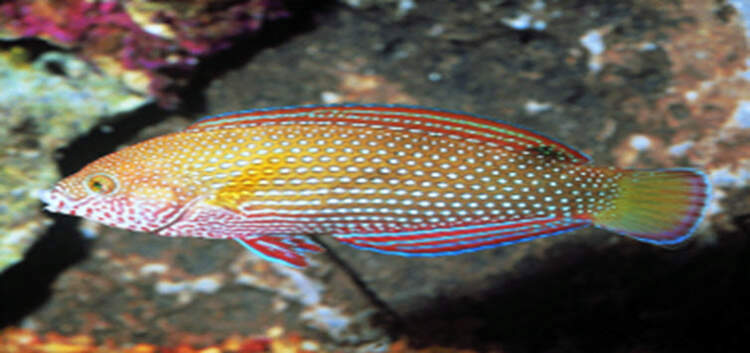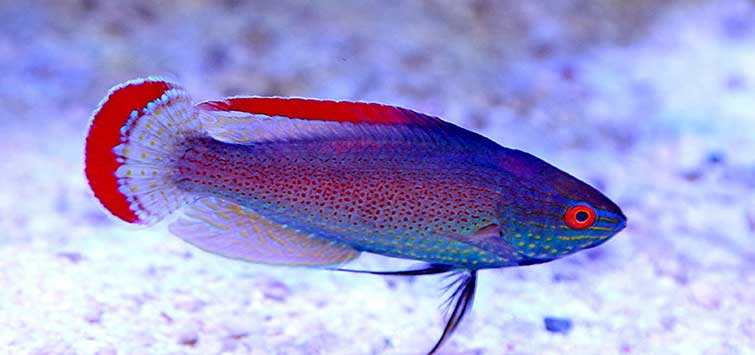The Best Wrasses for the Marine Aquarium
Author: Richard Aspinall
The wrasse family is notable for its astounding diversity and ubiquitous presence, which is what makes choosing an appropriate wrasse for your tank so challenging. One scuba diver and reefkeeper suggests some of the best wrasses for aquariums.
Wrasses Everywhere!
Wrasses of the Labridae family make up one of the largest and most diverse groups of fishes on the planet. Whenever I dive—be it in the warm tropical seas of the Indian Ocean or the cold, harsh seas of my native England—there is always a colorful wrasse, busily scouring the reef or rocks for food items.
Everywhere you look, you will find a labrid, be it a camouflaged species from the macroalgae-rich temperate zones or the colorful species of the reef that turn up in our fish stores. To put it simply, wrasses are everywhere and, to use scientific terminology, they are frequent and ubiquitous.
What Is a Wrasse?
There are around 600 species of labrids currently described, with over 80 genera that are occasionally in revision as genetic studies reveal relationships far deeper than morphology and coloration. Indeed, many labrids, such as those in the Cirrhilabrus and Paracheilinus genera, show considerable variation across their geographic range, with many other genera further confusing things for the expert and non-expert alike by showing significant changes in body shape and coloration as they move from juvenile to adult phases. Coloration is also determined by sex, to a greater or lesser extent depending on the genus and species.
Fishes in the family Labridae derive their name from the Latin Labrus, meaning lips, a point not lost on Rudie Kuiter. In his excellent book Fairy & Rainbow Wrasses and Their Relatives, he notes that in many parts of the world, wrasses are known as “lip fishes.” Furthermore, the genus Halichoeres, whose members possess a slightly upturned, pig-like snout, are honored with a name that translates as “salt pig.” Kuiter also notes that in addition to their obvious and often fleshy lips, many labrids have separate canine teeth and other dentition adapted for crushing, a point that won’t be lost on any aquarist who has lost crustaceans to one of the larger labrids.
Why Are Wrasses Such Excellent Aquarium Fishes?
Many wrasses make superb aquarium specimens, though some are recommended for experts only. While some have specific care requirements, there are wrasses that will delight novices and experts alike. Obviously, wrasses, like any aquarium inhabitant, deserve suitable living conditions; the aquarist must pay attention to the usual factors of water quality, provision of adequate swimming space, suitable aquascaping, and high-quality nutrition.
Most aquarium wrasses are very much reef fish and will benefit from aquascapes that use a lot of open, live rock structures that allow them to demonstrate their wild behavior; they spend a great deal of time swimming into and out of the reef, taking shelter, and hunting for various prey items in equal measure.
Many genera, as we will see, require deep sand beds for shelter. Some are bold and very hardy, while others are shy and retiring. The thing is, there is a wrasse for everyone and every tank.
Some of the Best Wrasses
The list that follows is perhaps quite a long one if you count up every possible fish. I’ve included some genera that contain quite a few species, but this further illustrates my point: Wrasses are wonderful fish and many of them can be wonderful in captivity. Having said that, I’ve also listed a few species that stand out from what is already a pretty impressive crowd.
Genus Halichoeres
Time after time, I return to the Halichoeres genus as one of the best for aquarists. Of the 70-odd species in the genus, most do not grow too large for medium-sized aquaria, and they are frequently imported and available in stores.
Halichoeres wrasses tend to be mild-mannered and will, in my experience, tolerate most tankmates.
They are robust and resistant to disease, though they can develop injuries from tanks lacking a suitable substrate. This is due to the fact that this genus sleeps underneath the substrate and requires small-grained sand at a depth of at least 2 inches for the larger fish, ideally more.
Feeding
Halichoeres wrasses are vigorous feeders and seem to enjoy most aquarium foodstuffs. They will take larger items and bash them against the rockwork to break them into smaller pieces, a technique they use with relish on invertebrates, especially small shrimps—aquarists take note.
On occasion, I offer my wrasses a treat of live isopod crustaceans. This sounds expensive, but they are, in actuality, nothing other than common woodlice. This practice may be considered risky and frowned upon by some, but I should add that I only collect these tasty morsels from land that has not had pesticides or herbicides applied to it.
Standout Species
While many in the genus make superb choices, several species stand out for praise. The yellow species H. chrysus and H. leucoxanthus reach around 10 cm (4 inches) and are both superbly colored. H. ornatissimus, H. margaritaceus,and H. marginatus also make excellent choices and share the complicated and colorful patterning of this species complex. I’m also a big fan of the red-headed wrasse H. rubricephalus because the male sports a superbly colored head. The female of this species, in common with many wrasses, could be easily mistaken for another species with her latitudinal yellow stripes.
Flasher Wrasses
Flasher wrasses from the Paracheilinus genus are a mainstay in the hobby, and deservedly so. Their pleasant demeanor, small size (usually less then 10 cm [4 inches]), and, of course, their superb coloration mark them as must haves for any aquarist.
“Flashes”
The “flasher” designation relates to males flashing their fins (dorsal, anal, and caudal) to females in an effort to win their favor. In the wild, this behavior often takes place when a number of receptive females gather in one spot and numerous males then gather to try to impress them, a mode of behavior replicated by species as diverse as grouse, seals, and certain bipedal apes on a Friday night.
Choosing Specimens
In the aquarium, it is best to acquire either a single specimen or a male and a small number of females and offer them foodstuffs that replicate their natural zooplankton diet.
Standout Species
Along with my personal favorite, P. octotaenia, McCosker’s flasher wrasse, (P. mccoskeri), Carpenter’s flasher wrasse (P. carpenteri), and the filamented wrasse (P. filamentosus) are all stunning fish that are well worth seeking out.
It should be noted that males of the species tend to be the most sought after due to their behavior, fins, and coloration. It is also worth noting that some aquarists with rather reluctant males use mirrors to try to encourage them to flash.
Fairy Wrasses
The genus Cirrhilabrus offers some truly exquisite fishes that have very similar care requirements to their cousins, the flashers. In the wild, several species of fairy wrasse may gather, which may suggest to aquarists that they can create a tank stocked with mainly Cirrhilabrus species. This should be avoided or attempted with great care, as the males can be very territorial and are reluctant to tolerate conspecifics or, on occasion, congeners (fish from the same genus).
Fairy wrasses are, however, quite shy and will be easily bullied be more belligerent fishes. Care needs to be taken to choose their tankmates wisely or else the wrasses may hide and eventually perish from lack of food. They are also well-known jumpers, so make sure your aquarium is covered. Once acclimated, the fish become quite bold and will swim happily in the middle to lower levels of the tank.
Standout Species
Several species are highly prized by aquarists: C. rubrimarginatus, C. lineatus, and C. rhomboidalis (a rare fish indeed) stand out from an already remarkable genus.
Possum Wrasses (Wetmorella spp.)
I find diminutive wrasses of the genus Wetmorella to be some of the most charming fish available in the hobby. They are recommended for systems with peaceful fish only, as possums are ideal targets for bullies that will cause them to retreat into the rockwork and succumb to disease or starvation if they continue to intimidate them and compete with them for food.
Tankmates and Feeding
Ideally, possums are best kept alone (in small- to medium-sized tanks) with peaceful tankmates in a system with an attached refugium that provides the small crustacean prey they adore. Cyclops, frozen Mysis, brine shrimp, and copepods are also taken with relish.
Swimming and Anatomy
Possums demonstrate a delicate swimming motion. Only the ends of the dorsal and anal fins are used to propel the fish as it hunts, using its large, highly mobile eyes to look for crustacean prey. The caudal fin is usable but kept in reserve for when a rapid getaway is needed.
Possums, being easily targeted by predators, adopted the ocellus (eyespot) somewhere in their evolution as a form of defense. I am unsure as to the nature of the pelvic fins; are they also ocelli?
My W. nigropinnata tends to flick its pelvic fins. Given their prominence, I’d be interested to find out whether this behavior has some purpose.
Anampses Wrasses
Wrasses of the genus Anampses are simply gorgeous, though, sadly, they can be difficult to feed. Having very specific care requirements, they are best reserved for hobbyists who have experience with finicky feeders—these fish will often refuse anything other than live food and possibly will never feed in captivity.
Cute—For a While!
Not all wrasses make good aquarium choices. Clearly many species are just far too big, but this doesn’t always stop them from being imported, a practice that must be discouraged. This is best done by aquarists researching potential purchases before handing over their hard-earned cash. Classic examples of this are some of the coris wrasses, which show significant variation between their juvenile and adult phases.
The clown coris (Coris aygula), for example, is a gorgeous fish with a pleasant demeanor. Its long, typical wrasse body is superbly marked, with orange blotches, two ocelli on the dorsal fin, and polka dots on the head. Who wouldn’t want such a fish in their tank? However, as time passes and the animal, with typical labrid gusto, continues to accept food, it will grow and grow. Before long, the fish can no longer be kept and a new home must be sought. It’s at this time that the aquarist may find their dealer is less interested in taking back a 12-inch monster than they were in selling a 2-inch cutie. The lesson is: research before buying.
Another species that gets far too large and problematic is the rockmover wrasse (Novaculichthys
taeniorus). Often sold as a charming juvenile, the rockmover, or dragon wrasse, grows rapidly, and as it continues to do so, it starts to live up to its name: It can remodel an aquarium rather quickly. Larger specimens are able to pick up large pieces of rubble and throw them around quite easily—not a fish you really want in captivity.
Wrasses for Everyone
Every hobbyist, at some time or another, should acquire a wrasse, or even several. There’s a wrasse for every hobbyist, for every tank, and for every habitat. With care, consideration, proper research, and forethought, this stunning group of fishes will continue to reward.

.png?h=595&iar=0&w=2781&hash=5FD5E69473BCC22199FBFA2FB71B6033)



